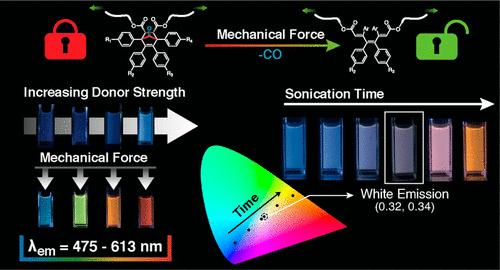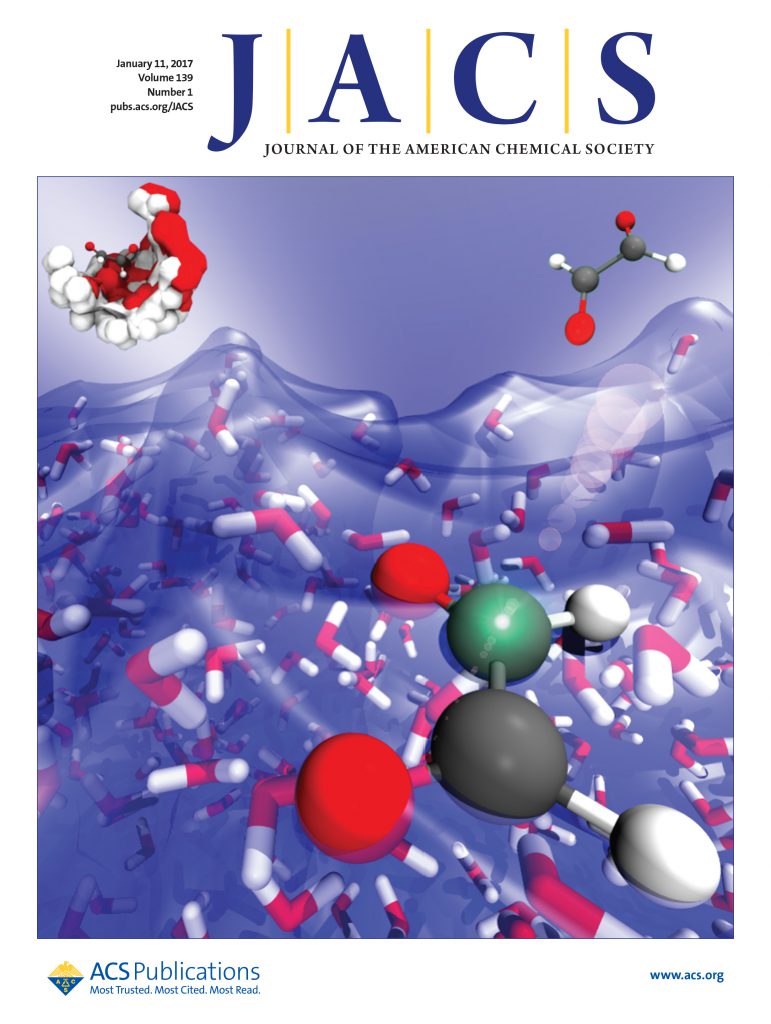Caged AIEgens: Multicolor and White Emission Triggered by Mechanical Activation
IF 14.4
1区 化学
Q1 CHEMISTRY, MULTIDISCIPLINARY
引用次数: 0
Abstract
Aggregation-induced emission luminogens (AIEgens) that respond to mechanical force are increasingly used as force probes, memory devices, and advanced security systems. Most of the known mechanisms to modulate mechanoresponsive AIEgens have been based on changes in aggregation states, involving only physical alterations. Instances that employ covalent bond cleavage are still rare. We have developed a novel mechanochemical uncaging strategy to unveil AIEgens with diverse emission characteristics using engineered norborn-2-en-7-one (NEO) mechanophores. These NEO mechanophores were covalently integrated into polymer molecules and activated in both the solution and solid states. This activation resulted in highly tunable fluorescence upon immobilization through solidification or aggregation, producing blue, green, yellow, and orange-red emissions. By designing the caged and uncaged forms as donor–acceptor pairs for Förster resonance energy transfer (FRET), we achieved multicolor mechanofluorescence, effectively broadening the color spectrum to include white emission. Additionally, we computationally explored the electronic structures of activated NEOs, providing insights into the observed regiochemical effects of the substituents. This understanding, together with the novel luminogenic characteristics of the caged and activated species, provides a highly tunable reporter that traces progress with continuous color evolution. This advancement paves the way for future applications of mechanoresponsive materials in areas like damage detection and bioimaging.

笼式 AIEgens:由机械活化触发的多色和白色发射
能对机械力做出反应的聚合诱导发光原(AIEgens)正越来越多地被用作力探针、记忆装置和先进的安全系统。大多数已知的调节机械响应型 AIEgens 的机制都是基于聚集状态的变化,只涉及物理变化。采用共价键裂解的情况仍然很少见。我们开发了一种新颖的机械化学解笼策略,利用工程化的降冰片-2-烯-7-酮(NEO)机械分子揭示了具有不同发射特性的 AIEgens。这些 NEO 机械载体被共价整合到聚合物分子中,并在溶液和固体状态下被激活。通过固化或聚合固定后,这种活化可产生高度可调的荧光,产生蓝色、绿色、黄色和橙红色发射。通过将笼型和非笼型设计为用于佛斯特共振能量转移(FRET)的供体-受体对,我们实现了多色机械荧光,有效地拓宽了色谱,使其包括白色发射。此外,我们还通过计算探索了活化近地天体的电子结构,从而深入了解了所观察到的取代基的区域化学效应。这种理解,再加上笼状和活化物种的新颖发光特性,提供了一种高度可调的报告器,它可以通过持续的颜色演变追踪进展。这一进展为机械响应材料未来在损伤检测和生物成像等领域的应用铺平了道路。
本文章由计算机程序翻译,如有差异,请以英文原文为准。
求助全文
约1分钟内获得全文
求助全文
来源期刊
CiteScore
24.40
自引率
6.00%
发文量
2398
审稿时长
1.6 months
期刊介绍:
The flagship journal of the American Chemical Society, known as the Journal of the American Chemical Society (JACS), has been a prestigious publication since its establishment in 1879. It holds a preeminent position in the field of chemistry and related interdisciplinary sciences. JACS is committed to disseminating cutting-edge research papers, covering a wide range of topics, and encompasses approximately 19,000 pages of Articles, Communications, and Perspectives annually. With a weekly publication frequency, JACS plays a vital role in advancing the field of chemistry by providing essential research.
文献相关原料
| 公司名称 | 产品信息 | 采购帮参考价格 |
|---|

 求助内容:
求助内容: 应助结果提醒方式:
应助结果提醒方式:


